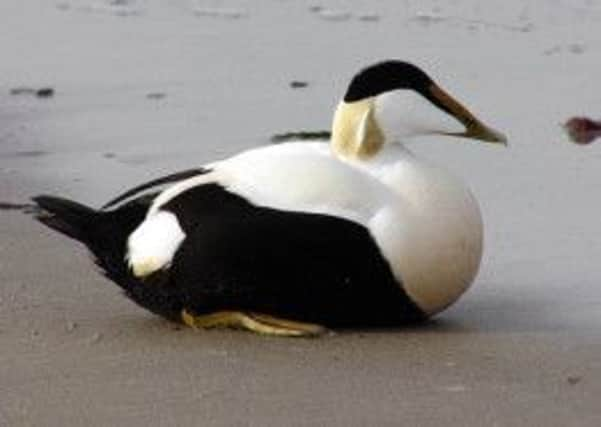Super ducks of the high seas fighting mysterious decline


EVEN if they’re not sure where it lives, many people can name a seaduck. The eider duck is probably the best known. It is from the soft breast of the female eider that we have plundered feathers to fill pillows and quilts for centuries.
Many of us associate ducks with the ceremonial feeding of stale bread in the local park, or riotous quacking ricocheting across a winter marsh.
Advertisement
Hide AdAdvertisement
Hide AdBut the eider is one of a hardy group of ‘super ducks’ that has set up home amid the pounding grey surf and screaming winds. Robust though they are, these ducks are in serious trouble, say experts.
Designed for unforgiving northern seas, the eider is a bird with ballast. An adult eider is twice the weight of a mallard and is reportedly the world’s fastest in level flight. But hearing these birds in conversation could cast serious doubt on their macho duck credentials.
With their conspiring ‘oooh, oooh’ calls they sound as though they’re getting stuck into a good gossip. Eiders may also be responsible for the birth of the environmental movement. St Cuthbert, a seventh century missionary living on the remote Farne Islands off the Northumberland coast, was so taken with the birds that he put in place rules to protect them during their breeding season.
The eider is relatively well known but other sea ducks such as the common and velvet scoter, scaup, long-tailed duck and red-breasted merganser are still relatively mysterious.
Advertisement
Hide AdAdvertisement
Hide AdLiving out at sea means we don’t come across seaducks very often and scientists, without the planes needed to cover vast distances to monitor them, have a hard time keeping tabs on their whereabouts and the ups and downs of population.
Seaducks are best seen around UK coasts during the winter, when they move south from their freezing northern breeding grounds.
It was assumed that the ducks were doing all right, but a recent report revealed a worrying problem. Massively reduced numbers were appearing at key European wintering grounds in the Baltic Sea.
It had been thought the birds might have shifted to new sites as a result of climate change, but this isn’t the case.
Advertisement
Hide AdAdvertisement
Hide AdTwo species have been particularly badly hit – the long-tailed duck, which flaunts a jet-black knitting needle-like tail, and the velvet scoter.
Around 60 per cent of long-tailed ducks, amounting to around 1.8m birds, have been lost. The situation is even worse for the velvet scoter, a soot-coloured heavy-set duck with a striking white eye-patch, which is believed to have slumped by 65 per cent.
The Moray Firth is the key UK site for the two ducks, and the latest data suggests their decline could be even greater there than in the Baltic Sea.
The slump is so bad that both have been added to the IUCN Red List – the global database of species at risk of extinction. The news is not much better for the other seaducks. Dramatic declines, ranging from 42-51 per cent, were also found for the eider, common scoter and red-breasted merganser. The cause is still not really understood.
Advertisement
Hide AdAdvertisement
Hide AdMark Simpson of the Wildfowl and Wetland Trust (WWT), says: “At the moment, there is a fair bit of speculation but little knowledge about what’s behind these declines. They could be due to reductions in nutrient loads (food in the water), increases in predation rates, small but regular oil spills and leakages, or by-catch in fishing nets.
“What is clear is that a number of potential threats exist, and most are increasing as use of the marine environment increases. These birds are still poorly understood, in terms of population structure, habitat requirements and general ecology, because they are physically difficult to study out at sea.
“Because this problem was largely unknown until recently, we’ve had to focus on raising a profile for seaduck conservation. It needs tackling throughout northern Europe, we lobbied the African-Eurasian Waterbird Agreement – the governing international treaty – to make seaducks a priority. As a result, we’re expecting a plan of action specifically for the long-tailed duck.
“These are all vital steps to get the international support and co-operation needed to conserve mobile species that freely migrate between countries.” The WWT is carrying out much-needed aerial surveys over UK waters to count wintering common scoter. Survey information has been used to influence the site of wind farms so the ducks are not harmed.
www.wwt.org.uk/waterlife